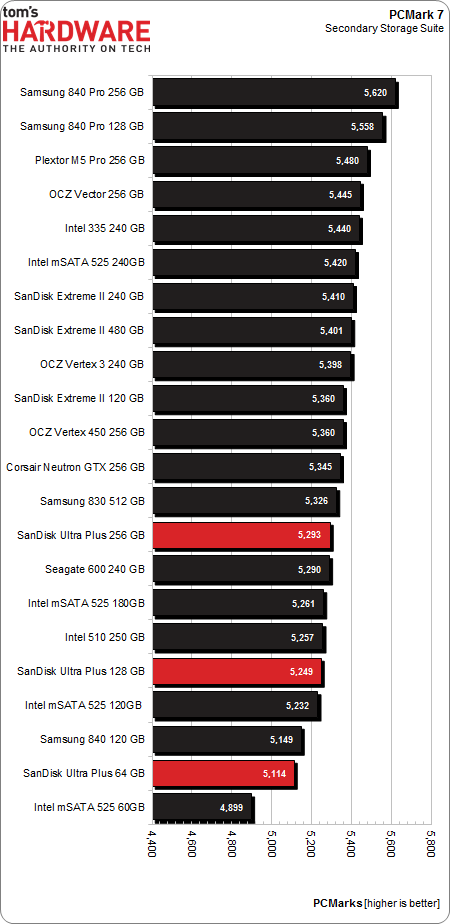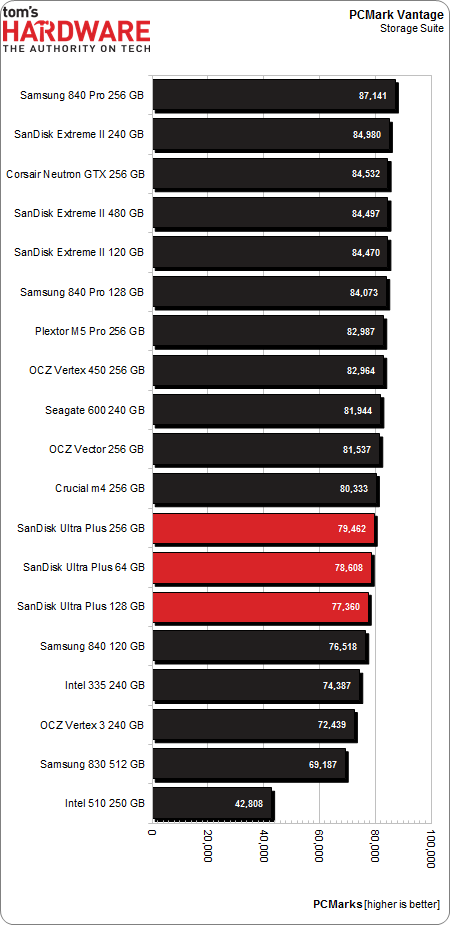SanDisk Ultra Plus SSD Reviewed At 64, 128, And 256 GB
SanDisk's Ultra Plus replaces the company's older SATA 3Gb/s SandForce-based Ultra with something a bit more modern, and with a budget-oriented price tag. We test all three capacities to see if the entry-level pricing belies a pocket rocket in disguise.
Results: PCMark 7 And PCMark Vantage
Futuremark's PCMark 7: Secondary Storage Suite
PCMark 7 uses the same trace-based technology as our Storage Bench v1.0 for its storage suite testing. It employs a geometric mean scoring system to generate a composite, so we end up with PCMarks instead of a megabytes per second. One-thousand points separate the top and bottom, but that encompasses a far larger difference than the score alone indicates.
PCMark 7 is a vast improvement over the older PCMark Vantage, at least for SSD benchmarking. The storage suite is comprised of several small traces. At the end, the geometric mean of those scores is scaled with a number representing the test system's speed. The scores generated are much different from PCMark Vantage, and many manufacturers are predisposed to dislike it for that reason. It's hard to figure out how PCMark 7 "works" because it uses a sliding scale to generate scores. Still, it represents one of the best canned benchmarks for storage, and if nothing else, it helps reinforce the idea that the differences in modern SSD performance don't necessarily amount to a better user experience in average consumer workloads.
Incredibly, the 256 GB Ultra Plus scores just ahead of Seagate's 600. That drive is unquestionably quick, and seeing the Ultra Plus beat it by just three points is good news for SanDisk. Both drives are similar in terms of flash technology, but the LAMD 87800AA controller in Seagate's SSD should have the baby Marvell out-manned and out-gunned. The 128 GB Ultra Plus isn't far behind, and the 64 GB is surprisingly fast.
The Extreme II family improves on the Ultra Plus to be sure, but those faster SanDisks bottom out at 120 GB. If you want a 64/60 GB-class drive, you could do (significantly) worse than the little Ultra Plus.
Futuremark's PCMark Vantage: Hard Drive Suite
PCMark's Vantage isn't the paragon of SSD testing, mainly just because it's old and wasn't designed for the massive performance solid-state technology enables. Intended to exploit the new features in Windows Vista, Vantage was certainly at the forefront of consumer storage benching at the time. Vantage works by taking the geometric mean of composite storage scores and then scaling them a lot like PCMark 7 does. But in Vantage's case, this scaling is achieved by arbitrarily multiplying the geometric sub-score mean by 214.65. That scaling factor is supposed to represent an average test system of the day (a system that's now close to a decade behind the times). PCMark 7 improves on this by creating a unique system-dependent scaling factor and newer trace technology. Why bother including this metric, then? A lot of folks prefer Vantage in spite of or because of the cartoonish scores and widespread adoption. That, and the fact that most every manufacturer uses the aged benchmark in box specs and reviewer-specific guidelines.
Get Tom's Hardware's best news and in-depth reviews, straight to your inbox.
Vantage reads and writes a comparatively small amount of data, and it might be a bit more targeted at 4 KB performance in some instances. Whatever's going on, the three Ultra Plus models are doing it in lock-step. Sure, they score a little better as capacity increases, but the delta between 64 and 256 GB is miniscule to be sure. It looks as though the similar random performance among the trio results in Vantage scores within a whisker of each other. Nice.
Current page: Results: PCMark 7 And PCMark Vantage
Prev Page Results: Tom's Hardware Storage Bench v1.0 Next Page Results: Robocopy File Transfer Performance
